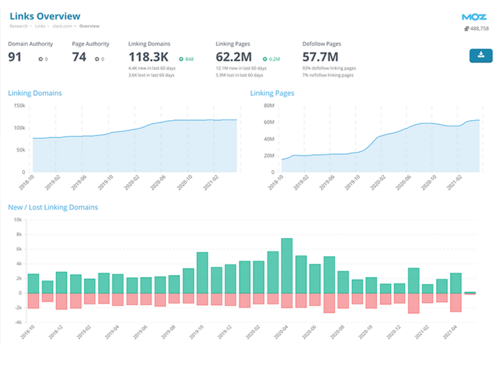Other factors
Of course, a link building package depends on various factors, such as budget, objectives and the current link profile of the website. Our link building service can advise you on this so that you always have the right link building package if you want to outsource your link building.
Rates online marketing – No fixed contracts!
B. Analyzed does not work with long-term contracts. We are a flexible online marketing agency, registered in Venlo that thinks along with our customers.
Every month we determine together which marketing service(s) will be given attention and where the focus will be. You do not have to purchase an extra package if you want to use one of our other services.
Tailor-made link building
Because the size, the level of difficulty and the wishes of customers are different for every project, we first exchange ideas with each other. As soon as the wishes and current situation are clear, and we have a good idea of your current link profile and what link building strategy is needed for your company, our link building specialists can set up a link building process. In this way we provide the most effective link building strategy!
Curious what B. Analyzed can do for your company? Thinking of outsourcing link building? Contact us, request a quote or do a free link building scan here to determine how your website is doing. We are happy to help you increase your link building and your findability in Google!
What is link building?
Link building is the practice of earning hyperlinks (or “backlinks”) to your website with the goal of increasing your website’s authority and visibility in the organic search results. Link building offers SEO value in the form of authority signals and referral traffic.
Common types of link building
There are many ways to “build” backlinks — and we’ll talk about them later on in this article. But at a high level, the most common link building strategies include:
- Direct or email outreach
- Content marketing
- Blogging
- Guest blogging
- Creating how-to guides or tools
- Resource pages
- Running Public Relations campaigns
- Fixing broken links
These are the methods you will see mentioned most often in link building guides. These strategies are relatively easy to understand, but succeeding with these strategies depends greatly on the competitiveness of your market, content, and industry.
Benefits of link building for websites
Link building is an SEO technique that helps website owners increase their organic search ranking by providing relevance cues and lending authority to a website. Having a high number of quality backlinks helps Google interpret your website as credible.
Here is why link building is important for SEO:
- Credibility - Quality backlinks are essentially votes of confidence from relevant websites saying that your website provides helpful, accurate, and engaging information. This makes your website look more favorable to search engines.
- Rankings - A high number of high-DA backlinks to your website can improve your website’s keyword rankings and therefore visibility in the search results.
- Traffic - Backlinks from other websites can help direct additional users (i.e. traffic) to your website.
- Revenue - Backlinks may present more revenue opportunities and sales via referral traffic.
- Performance - Link building can contribute to better performance metrics, like your own site’s DA, keyword positions, organic impressions, and more.
- Partnerships - The practice of link building and outreach can help you form valuable relationships and partnerships with other business owners and bloggers in your industry.
- Authority - Creating great content with the purpose of earning links can help build up your website’s authority, both in terms of voice and DA.
- Content Marketing - Link building as an activity often means blogging, sharing content on social media, running email campaigns, etc. All of this can come together to support your larger content marketing strategy.
Types of links you should know
There are many types of links in SEO, and not all of them are “backlinks”. Before you dive into your link building strategy, it’s important to know the various types of links and how they apply to your website.
Backlinks
As mentioned previously, backlinks are links from outside websites that point “back” to your website. For example, another company linking from one of their blog posts to a page on your website is an example of a backlink.
Internal links
Internal links are links from a page or post on your website that links to another page or post on your own website. For example, an SEO best practice is to link from your existing blog posts to other related blog posts on your website.
Broken links
Broken links (whether broken backlinks or broken internal links) are links that were originally pointing to an end source, but that source has since been removed or is no longer live. This will often result in a 404 error saying that the page cannot be found.
Dofollow links
“Dofollow” is a designation made by the link source (whether your own site or the outside site linking to yours) that tells search engines to “follow” the authority of that link to the end source. In other words, it’s a coded descriptor that tells search engines to crawl the link and count them as providing authority to the end source.
Nofollow links
On the other hand, nofollow links have a designation telling search engines not to count these links or interpret them as lending authority to the end source. Many websites set their outbound links as nofollow if they don’t want to “lose” their own authority to the website they are linking out to.
External links
External links are outbound links from your website to another source. Any time you link to another website or domain – whether owned by you or someone else – this is an external link. You can designate your external links as either dofollow or nofollow.
Editorial links
Editorial links are backlinks that are earned from an editorial source, in which the source links to your website organically (i.e. unpaid). Editorial links are often earned by you publishing high quality content and/or marketing your content on other platforms, like social media.
Referring domains
“Referring domains” is a label used in common SEO tools to measure how many individual domains are linking to a website. Rather than specifying the number of unique URLs, this simply states which overall domains are linking to you. From here, you can assess the authority and relevance of each domain.
High quality links
High quality links – links coming from relevant websites with high domain authority and content quality – are what you want. Search engines love to see that popular, high authority sites are linking to you, and this is often preferable to a high volume of low-quality links.
Relevant links
You may see the term “relevant links” used often in link building guides. While relevance is difficult the measure, the idea is that you are earning links from relevant websites and blogs that cover topics relevant to what your business offers. These links essentially tell Google that a similar website is finding value in your content and that it altogether matches what users in your market are searching for.
How to develop a successful link building strategy
Ready to start link building? We’re here to help! Here’s how to get started with link building to improve your website’s SEO.
1. Analyze your website with SEO tools
SEO tools like Ahrefs.com and Moz.com allow you to audit your website and analyze your existing backlink profile. Here, you can get a baseline of how many backlinks you already have, what your DA is, how your backlinks have increased or decreased, and more powerful metrics.
With SEO tools, you can also see:
- Whether you have lost any backlinks or have any broken backlinks
- Which domains are linking to your competitors
- Which pages on your website are being linked to the most
- Whether there are any spam or low-quality backlinks pointing to your own site
- Existing keyword performance and new keyword opportunities
Use these tools to your advantage to see your existing backlink profile and find new link building opportunities.
2. Know your niche
Link building is very often about creating quality content that attracts your target audience and referring websites. Knowing your niche – and your audience – will help you think up content topics that could earn you links.
Consider conducting market research to uncover more insights about your target users. Brainstorms topics you think your audience would be interested in. Use SEO tools to find keywords your audience is actively searching for.
Further, competitor research can help you uncover untapped content and backlink opportunities. Rather than going broad, your link building approach can then focus on creating highly targeted content, reaching out to industry-related websites, and forming partnerships with other players in your niche.
3. Create a list of websites
SEO tools and manual research will help you surface websites that could be a good fit for your link building strategy.
For example, if you have a travel agency, you may start creating a list of other domains in the travel industry. Think travel blogs, travel agency sites, travel magazines, and the like
Once you have a list of domains, you can begin brainstorming your outreach or content marketing strategy. This may involve emailing the websites directly or creating valuable content that would attract them organically.
4. Write engaging content
It’s hard to do link building without content. High quality content can attract users, build links, generate views on social media, get circulated online, and so much more.
Be sure to write blog articles and web pages that appeal to your audience. Some best practices include:
- Telling a story that engages readers
- Providing a list of tips or facts readers can’t find anywhere else
- Adding value with interviews, videos, and PDFs
- Including high-quality images and graphics
- Breaking the text into smaller sections, making your content easier to read
- Adding internal links to relevant pages on your website
- Linking externally to valuable, reliable sources
- Providing practical advice, case studies, tutorials, and more
This type of content will keep readers engage and will be more likely to build links from other websites. The key is to provide better information and a better web experience than what readers can find elsewhere online.
5. Get to blogging
When it comes to building links, blog posts are the way to go. Not only do blog posts inform and entertain readers, but they can be a landing place for new links.
Before you write a new blog post, you will want to research what topics readers (and site owners) may be interested. Using your SEO tools, look into blog post topics related to your business, the interests of your target audience, and trending topics in the industry.
Blog posts can work wonders for your website, your content marketing, and your social media marketing. Here are a few blog post ideas to consider:
- "How-to" blog posts
- Interview-style blog posts
- Blog posts with embedded videos
- "Best of" blog posts
- "Roundup" blog posts
- Resource pages and articles
- Guest blogging articles
Blogging is one of the top link building strategies you can use today. You'd be surprised how many links you can get by just posting high quality content and guest posting!
6. Circulate or pitch your content
While the ideal is to earn backlinks organically, it can’t hurt to give your content a bit of momentum.
After you hit “publish”, share your content on social media, to your email list, and beyond. This is a great way to get more eyes on your content, which could lead to more backlinks.
Alternatively, you can reach out directly to other sites asking them to read and link to your content. Just know that this can yield minimal results, and some sites may ask you to pay for a link. Never pay for a backlink using this method, as it’s a good way to end up with a nofollow link or spam.
What are the best link building strategies?
Believe it or not, link building hasn’t changed a ton over the years.
Some of the traditional methods still work today (though, some have long been extinct). That said, here are some of the best link building strategies people are using.
Backlink “hunting”
“Hunting” for backlinks has traditionally meant searching the web for relevant sites you want to build links from. Now, with today’s technology, it means spying on your competitors’ backlinks!
Using your chosen SEO tools, search for your competitor’s domain. The report will likely show their backlink profile overview, referring domains, number of domains, and more.
Now, look at the referring domains. Make a note of which domains seem relevant to your website. Then, take note of the actual URL source (the page or post) and see whether there’s an opportunity for you to get featured in this same source.
Sometimes, reaching out to the source can result in you getting a link too. Other times, you will just have a list of domains of which to target with your content marketing or outreach.
Help a Reporter Out
Help a Reporter Out (HARO) is essentially a free subscription that sends you notifications whenever journalists and publishers are looking for sources. You will get an email when someone is looking for information about a topic, and then you can respond with your two cents in hopes of getting featured.
Placement in an article is never guaranteed, but HARO is a method that’s worked well for a range of industries. The key is to respond as quickly as possible, start with a friendly opener, and provide valuable and accurate advice.
Mend broken backlinks
Broken backlinks pointed to your site are perhaps the best “low hanging fruit” when it comes to link building. These are websites that have already linked to your site, but perhaps the original page was removed or a technical error is causing a broken link.
You can use SEO tools for broken link building. Then, you can message the domain and kindly request that they re-add a link to your website or otherwise ensure the original source is made live. Sometimes, this is just a minor oversight and they will re-add your link to the original source or a new source.
Reach contributor status
Many people know about guest posting (posting on other relevant sites) as a way to build links. But it can be tedious and disheartening to try and form new partnerships and pitch your articles to multiple sites.
This is why reaching contributor status is key. This means putting in your time to form partnerships with a few key websites you can write for on a regular basis. This helps guarantee a publishing spot and allows you to build trust, which could mean more backlink placements.
This requires a slow and steady approach. Networking, sharing value on forums, publishing great content on your own blog, and attending events are all great ways to try and earn contributor opportunities. This legwork can really pay off in the long run.
Stay on top of “best of” trends
It seems like every day there is new trending topic – whether about world news, technology, pop culture, food, and beyond. These present opportunities to create engaging, link-worthy content.
Google Trends is a great place to find trending topics and capitalize on this momentum. Simply use the search engine to discover hot topics, and then turn these topics into new content.
“Best of” blog posts are a great start. For example, if you see that “blockchain” is trending, an article like “Best Blockchain Technology You Need to Know in 2022” could be a smart topic. Another could be “Best Blockchain Platforms for Game Developers” or the like.
Targeting trending topics makes your content inherently searchable. Using the term “best” makes it more clickable. This is the winning combination when it comes to creating content that attracts, engages, and earns links.
Conclusion: Link building strategies don’t stop there
Link building is only confined by the limits of your own imagination. Wherever content can be created, there is an opportunity to use it toward your link building advantage. The most recentSurfer integration with SEMrush, featured in SEJ,helps you to find relevant backlinks that your competitors are using, and streamline your backlinking strategy.
Also, YouTube video marketing could allow you to go viral, direct users to your blog, and build links that way. TikTok could help you grow a massive following, drive users to your website, and earn links from other publishers. The sky is the limit.
Don’t feel restricted by “traditional” link building strategies. You should always be looking for new ways to provide value to your target audience and build authority in your industry. This philosophy sets you up for success in building lucrative partnerships, earning high quality links, and attracting more organic traffic.
if your website is listed here you are getting juicy 75 DA dofollow backlink!






